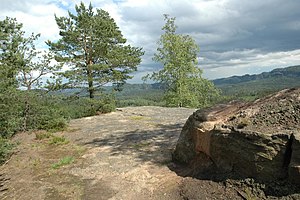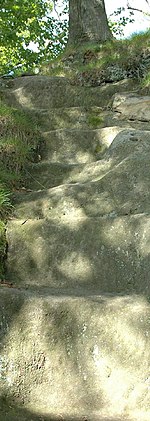Wildenstein Castle (Saxony)
| Wildenstein Castle | ||
|---|---|---|
|
Summit plateau of the former castle complex |
||
| Alternative name (s): | New Wildenstein | |
| Creation time : | 1409 | |
| Castle type : | Höhenburg, rocky location | |
| Conservation status: | Castle ruins | |
| Standing position : | Knighthood | |
| Place: | Bad Schandau | |
| Geographical location | 50 ° 55 '32.5 " N , 14 ° 15' 25.6" E | |
| Height: | 337.1 m above sea level NN | |
|
|
||
The Wildenstein Castle in Saxon Switzerland is the ruin of a rock castle near Schmilka in District Saxon Switzerland-Eastern Ore Mountains in Saxony . There are still beams, remains of walls, steps and rock drawings.
Geographical location
The ruin is located in the Saxon Switzerland National Park 4 kilometers north-northeast of the at the same situated Schmilka , a district of Bad Schandau , and 2.4 km southeast of Lichtenhain , a district of Sebnitz . It is located in the Ostrau district south of the Kirnitzsch valley on the Neuer Wildenstein mountain ( 337.1 m above sea level ) above the cowshed .
history
Wildenstein Castle belonged to the Bohemian aristocratic family of the Berka von der Dubá and was built in 1409 by Hinko II of Dubá. In 1410 he handed over the rule by dividing the estate to his second son Heinrich von der Dubá, who then moved from Schwarzberg Castle to Wildenstein. The Wildenstein dominion was separated from Hohnstein . The small rock fortress on the Old Wildenstein was not suitable as the center of power , which is why the rock fortress on the New Wildenstein was further expanded and made the center of the rule. This rule included the cities of Neustadt and Sebnitz and 18 villages with a total of 233 men liable to pay interest.
Through feuds , mismanagement, fragmentation of property and the general decline of the knighthood, the Berka family sank into robber baronism . Since the Berken allowed themselves attacks on Saxon and Episcopal Meissen territory on their raids and threatened the trade routes of the Upper Lusatian Six Cities, they were fought in a targeted manner. The Electorate of Saxony and the Six Cities League besieged Wildenstein Castle for the first time in 1425.
During another siege in 1435, the castle was taken. After mediation by Emperor Sigismund , the Saxons withdrew in 1436. On the basis of this peace agreement, there was even a brotherhood in arms with the Electorate of Saxony in 1436 to besiege the robber baron fortress Arnstein . Breaking their word, the Berken started raiding again in 1437, so that the castle was conquered again in 1439/40. The subsequent peace promise was broken again by the Berken.
The rule of the Berka von der Dubá finally ended in this area when on April 8, 1451 the rule of Wildenstein passed to the Wettins .
Access
A good starting point for Wildenstein Castle is the Lichtenhain waterfall , which can be reached by bus or car via Bad Schandau . However, we particularly recommend arriving on the Kirnitzschtalbahn, which is over 100 years old . From the waterfall you walk on the Kuhstallstraße, a walkable path, to the cowshed . Arrived at the cowshed, the sky ladder then leads to the robbery castle. Allow 50 minutes for the entire duration.
Individual evidence
- ↑ Map services of the Federal Agency for Nature Conservation ( information )
- ↑ Bibliographisches Institut Leipzig: Heimat- und Wanderbuch, Elbe Sandstone Mountains (1956)
- ^ Matthias Donath: Castles in Saxon Switzerland and in the Eastern Ore Mountains. Edition Sächsische Zeitung, Dresden 2006
- ↑ Dumontreise: Hiking in Saxon Switzerland. ISBN 3-7701-5319-7
- ^ Alfred Meiche : Castles and prehistoric dwellings in Saxon Switzerland. Wilhelm Baensch Publishing House, Dresden (1907)
- ^ Berg- & Naturverlag Peter Rölke, Dresden: Hiking & Nature Guide Saxon Switzerland. Part 1 (1999), ISBN 3-934514-08-1 .





